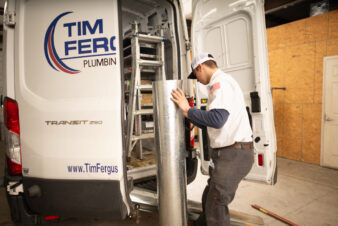
As a contractor you must realize that Energy has become a defining issue of our time and Climate Change is a concern that we can no longer choose to ignore. Super Storm Sandy has reinforced the growing sense, in political circles, that the reality of Climate Change puts our Nation at risk. The entire face of New York and New Jersey has been dramatically changed by the effects of that storm, in the five boroughs of New York City, the devastation has been estimated at over $30 billion.
The Department of Energy states building lighting, appliances, space conditioning and water heating account for 36% of primary energy in the United States. This is far greater than the total energy used in the transportation sector and nearly equals that of the industrial sector, two thirds (2/3) of that is supplied by electricity. Forty percent (40%) of the total energy used, in those buildings, is for space conditioning (heating & cooling) and water heating!
A recent study conducted by the Rockefeller Foundation and DB Climate Change Advisors, supports that fact and point out that upgrading and replacing energy consuming equipment, in buildings, offers an important capital investment opportunity with the potential for significant, economic, climate and employment benefits. They go on to state that “an investment, in this type of initiative, could yield more than $1 trillion of energy savings over 10 years, equivalent to saving approximately 30% of the annual electricity use in the US.”
Geothermal Heat Pump systems (GHPs), a technology that uses the earth’s thermal properties, in conjunction with electricity, to provide space conditioning and water heating to facilities and one that the US Environmental Protection Agency (EPA) has stated reduces Greenhouse Gas emissions by up to 40% over conventional HVAC systems, can accomplish these goals.
A report released, in 2006 by the National Research Energy Laboratories (NREL) states that, there were more than one million geothermal heat pump systems in use nationwide. Since then we estimate that number has grown to approximately 1.5 million. While this is a large number, it still represents less than 2% of all heating and air-conditioning units in the United States.
Although the geo footprint is a small one, those units have had a significant combined effect on energy savings and environmental issues.
• Conserved over 31 million barrels of crude annually, reducing our dependency on fossil fuel.
• Eliminated approximately 9 million tons of CO2 (equivalence of taking 2 million cars off the road or planting about 748 million trees).
How can we accomplish this?
One of the main barriers and some think the only barrier, is first cost. The primary cause of this is the installation of the geothermal heat exchanger (GHE), which represents over 90% of the cost of a system. The goal is to remove that barrier by taking the geothermal heat exchanger out of the equation for the end user. The model that would work best is to have the GHE become an asset owned by a third party, preferably a Utility (electric or gas, Investor owned, Co-Operative or Municipal). This would be a “rate recoverable” business unit and would enable the company to take advantage of the numerous benefits the GHE represents, such as:
–Permanent Demand Reduction, (.55kW to .88kW reduction per ton of installed GHE) A reduction that requires no notification and delivers 365 days per year.
– Renewable asset, the states of Maryland and New Hampshire have made GHPs an accepted technology available for Renewable Energy Credits (REC’s) under the State’s Renewable Portfolio Standard (RPS) mandate. This allows Utilities to take credit for thermal load avoided.
This technology enables an entity to become the space conditioning (heating AND cooling) provider for a facility, reducing energy costs, saving water and providing comfort for the end user by moving energy from the ground to the facility.
What are the potential benefits to be derived from an increase to 30%
Fossil Fuel Savings: @ 30% = 175 billion KWh reduction per year.
Dependency on Fossil Fuels: @ 30% = over 477 million barrels crude oil saved per year
Power Reduction: @ 30% = Reduction of electric demand by over 36,564,000 KW or 36,564 MW demand reduction per year. (1 ton of geo loop capacity reduces demand by .55- .88 kW).
Power Production: @ 30% = the amount of energy (BTU to kW conversation) taken from the ground, by these systems. 306,771.96 MWH per year.
Environment: @ 30% = More than 35 million metric tons of carbon and more than 130 million metric tons of CO2 annually. Equivalent of removing 29 million cars or planting 8.5 billion trees per year.
Economic Development: @ 30 % = 5 million jobs will be created or retained, within this industry in order to achieve this goal and numerous other economic benefits occur.
The initiative’s success depends on continuing to accelerate the development of a sustainable infrastructure, through professional development training, in all facets of the GHP technology. This can be accomplished by supporting the accredited training courses in installation, drilling and looping which have been developed by our industry and are currently available to you the contracting professional.
To recap, the goal is to gain a 30% share of the HVAC market for safe, efficient and renewable geothermal heat pump technology. You can become a part of this initiative to capture the benefits of Energy Independence & Security, Environmental Stability and Economic Prosperity and create a sustainable energy future in the US, for generations to come.
John (Jack) P. DiEnna Jr. is the Executive Director of the Geothermal National & International Initiative. He can be reached at jdienna@geo-nii.org.




Join the conversation: